Dressing up Toronto for the Pan Am Games
by all | 8 September 2015 12:06 pm
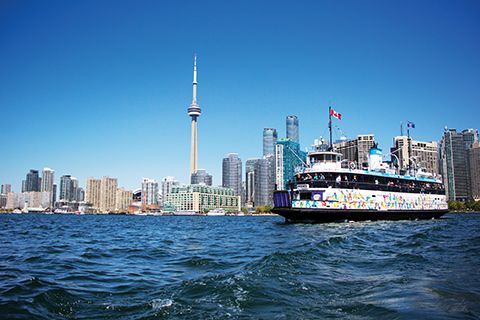 [1]
[1]Photos courtesy Holman
By Peter Saunders
From July 10 to August 15, Ontario hosted the 2015 Pan Am and Parapan Am Games, the largest international multi-sport event ever held in Canada. More than 6,000 athletes participated in 140 events at 32 venues across the province’s Golden Horseshoe region, with Toronto serving as the focal point.
Toronto’s municipal government, for its part, undertook a special ‘welcome and engagement’ marketing campaign to help generate excitement, ensure broad citywide awareness and ‘dress up’ the city in preparation for the games. This signage-based campaign comprised four key, high-impact elements:
- A ferry wrap and corresponding terminal signage.
- A series of out-of-home (OOH) advertisements at transit shelters, featuring three-dimensional (3-D) sculptures.
- A street-pole banner program.
- A colourful Toronto sign at Nathan Phillips Square, in front of City Hall.
Ferry wrap
Among the largest-scale initiatives for promoting the games in Toronto was the application of colourful wrap graphics to the Thomas Rennie, one of the city’s iconic ferries on Lake Ontario that transport passengers between the city’s waterfront and the Toronto Islands.
“This was a unique, one-off situation to celebrate the games and, I believe, the first time any of our ferries has been fully wrapped, including the bow, stern, upper deck and sides,” says Kimberly Bain, Toronto’s marketing supervisor for economic development and culture.
Bain worked with TO2015, the games’ organizing committee, to incorporate its colourful ‘United We Play’ themed graphics into the ferry wrap design, following the committee’s established branding guidelines. She also worked closely the municipal parks, forestry and recreation division, which operates the vessel.
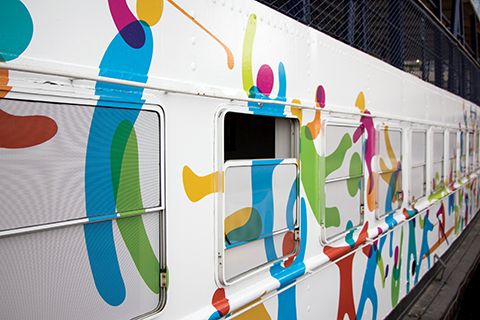 [2]
[2]Perforated films were applied to the windows, allowing passengers to see outside.
“We knew the graphics would look great on the water,” says Bain, noting the iconic ferries are highly visible each summer. According to the city, between the May and September long weekends, one million residents and visitors use them to cross over to the islands. “And this year, there would be Pan Am sailing events in the harbour.”
Given the lead time necessary to wrap the Thomas Rennie before its operational season, the project was the first part of the overall campaign to get started. In November 2014, the city issued a request for proposals (RFP) to find a vendor who could manage all aspects of the wrap, along with the complementary banners and posters at the mainland’s Jack Layton Ferry Terminal.
In January 2015, the contract was awarded to Toronto-based Holman. Founded in 1964 and known for designing branded displays and environments for retailers, trade shows, museums and special events, the company won the job with its full-service capabilities.
“It’s certainly unusual to wrap a boat—and this was the first time for me—but we can pull in the right people to work with on large projects when these kinds of opportunities arise,” says Mark Wojtowicz, graphics manager for Holman.
One of the primary challenges was determining measurements for the graphics. As wrapping the entire ferry—which was built in 1951—had no precedent, there were no existing specs for Holman to work with.
“We started blind,” says Bain. “Holman had to spec it all from nothing.”
When designing all elements of the wrap, Holman adapted existing TO2015 graphics into an overall ‘wave’ scheme, so as to meet the committee’s requirements and come up with an eye-catching pattern.
This process also involved designing the artwork with the physical realities of the vessel in mind. Perforated films, for example, would be used along the windows to ensure a complete image was created on the exterior while passengers on-board could see outside.
“And we had to design the graphics to allow for these windows being opened,” says James Cummings, project manager for Holman.
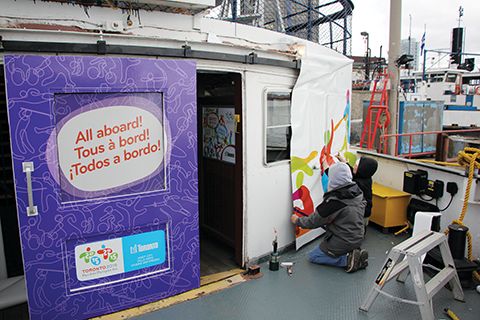 [3]
[3]The ferry graphics marked the first time Holman has wrapped a boat.
The company also specified a variety of substrates for the job.
“The undersides of the ferry’s ramps are wooden,” Cummings explains, “so we first had to attach Dibond aluminum composite panels to them, before we could apply vinyl graphics.”
Holman printed the wrap artwork on 3.7-m (12-ft) long 3M vinyl panels, using its HP Scitex flatbed printer. Coroplast corrugated plastic and polystyrene (PS) posters, mesh banners and translucent backlit graphics—for existing lightboxes inside the ferry—were also printed on the flatbed, with only fabric pennants farmed out to Flags Unlimited in Barrie, Ont., which printed them with dye sublimation technology before stitching them.
“We try to do as much as we can in-house,” says Cummings.
The wrap was installed the week of May 11, to ensure it would be completed on time for the Victoria Day weekend, which marks the start of the ferries’ operating season, but this meant a tight timeframe.
“We had to complete the installation before the long weekend,” says Bain, “but because the harbour was iced over much later than usual this year, due to a harsh winter, my colleagues in the parks department couldn’t get the ferry in and out of dry dock as early as originally planned. The delay condensed Holman’s installation time down to less than one week.”
“We just had four days to do it, between May 11 and 15,” says Cummings, “and it was tricky work. A cherry picker couldn’t reach the ends of the vessel, so we had to hang from ramps at the sides of the yard. The install also took longer than we thought because it was wet and windy.”
At the same time, as mentioned, posters and banners were also installed at the mainland terminal, showcasing a variety of Pan Am and Parapan Am messages.
“We took over the whole terminal with a sort of mini domination campaign,” says Bain, whose OOH industry experience includes previous work for Pattison Outdoor Advertising.
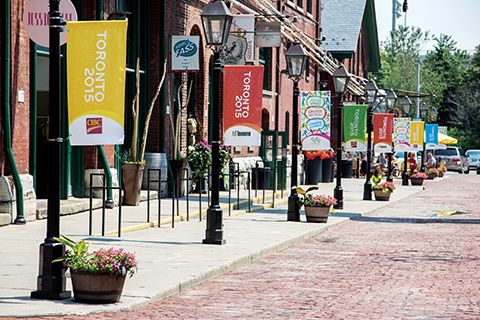 [4]
[4]The street banner program was the city’s largest-scale to date.
Despite the lack of precedent, the project was a success.
“Everything with Holman was very turnkey,” Bain says, praising both the appearance of the ferry and the company’s prompt response time when there was trouble, such as when posters in the ferry needed to be replaced due to water damage.
“We did a weekly check on all of the graphics because of concerns about vandalism and other damage,” says Cummings. “The city was worried the wrap vinyl could get scuffed, but fortunately it didn’t. There were no major hiccups or issues.”
The terminal posters were removed shortly after the Parapan Am Games ended in mid-August, but the wrap could not be removed until after the ferry season concluded on the Labour Day weekend in early September.
OOH ads
The mascot for the 2015 Pan Am Games was Pachi, a porcupine with 41 multi-coloured quills, representing each of the participating countries. His species was an appropriate choice, as porcupines are found throughout North and South America, including more than 20 of the countries competing in the games.
 [5]
[5]Astral Out-of-Home affixed 3-D sculptures of Pachi, the games’ mascot, to four of its transit shelters.
One of the ways the city sought to generate local excitement for the games was to have Astral Out-of-Home create and affix 3-D sculptures of Pachi to the roofs of four transit shelters. These were accompanied by traditional posters inviting pedestrians to take photos with Pachi and share them via social media, using the hashtags #HostCity2015 and #PACHI.
The sculptures and posters were installed at shelters near four intersections across Toronto: Jane Street and Finch Avenue; Kennedy Road and Lawrence Avenue; Yonge and Dundas Streets; and Bay and Queen Streets. They remained up for eight weeks, from June 22 to August 14.
Meanwhile, Pachi decals and posters were displayed without sculptures for the same period at transit shelters near four other intersections across the city: Yonge Street and Sheppard Avenue; Danforth and Victoria Park Avenues; Queen Street and Carlaw Avenue; and Lakeshore Boulevard and Kipling Avenue.
Street banners
Toronto’s ‘host city’ campaign also saw more than 4,000 vertical banners installed on electrical utility poles across the city, both to welcome athletes and other visitors and to generate stronger local awareness of the Pan Am Games.
The largest banner program to date in Toronto, it especially targeted areas surrounding local game venues and along major transportation routes in the Pan Am network, but also spanned all 77 of Toronto’s business improvement areas (BIAs) and 44 municipal wards.
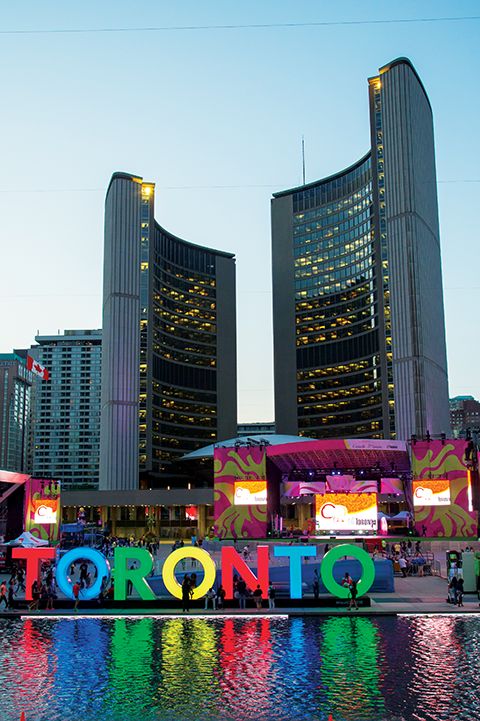 [6]
[6]The Toronto sign was positioned for photo opportunities with City Hall in the background and its own reflection in the pool.
Toronto sign
Finally, in early July, an illuminated dimensional sign spelling out ‘Toronto’ was set up along the northwest corner of a reflecting pool in Nathan Phillips Square, a public space in front of City Hall. Municipal employees were inspired by similar dimensional-letter branding installations around the world, particularly one for Guadalajara, Mexico, during the previous Pan Am Games in 2011, as well as the Olympic rings in Vancouver for the 2010 Winter Olympic Games.
The Toronto sign was positioned for photo opportunities, with City Hall’s two towers in the background and the sign’s own reflection in the pool. An ideal photographer’s position was even marked with street decals on the south side of the pool, in the hope of—much like the Pachi sculptures—inspiring the public to share their photos via social media with their friends and families on an international scale, using the hashtags #share3DTO and, again, #HostCity2015.
That said, while the sign was introduced as part of Panamania Live, an arts and culture festival coinciding with the games, it will remain in the square until the end of the year, then possibly tour other popular parts of the city, with an estimated lifespan of three to five years.
“The sign is a great way to showcase our city’s pride in a fun and interactive way, both during the games and beyond,” says John Tory, Toronto’s mayor.
Each of the seven individual dimensional letters in the 3 x 22-m (10 x 72-ft) sign—which use the Azo Sans Bold font—was constructed with a steel frame, aluminum cladding and translucent polycarbonate front and back panels, weighs about 136 kg (300 lb)—for a total sign weight of 1,180 kg (2,600 lb)—and rests on a 1,180-kg (2,600-lb) plinth (i.e. base). They contain approximately 396 m (1,300 ft) of light-emitting diodes (LEDs), which can be transitioned to create 228 million colours via wireless-fidelity (Wi-Fi) control. They also feature colourful vinyl side wraps that can be removed, enabling them to be ‘reskinned’ with different designs for other occasions in the future.
With files from the City of Toronto and Holman. For more information, visit www.toronto.ca[7] and www.holmanexhibits.com[8].
- [Image]: http://www.signmedia.ca/wp-content/uploads/2015/09/PanAm_TorontoFerryWrap.jpg
- [Image]: http://www.signmedia.ca/wp-content/uploads/2015/09/Ferry15.jpg
- [Image]: http://www.signmedia.ca/wp-content/uploads/2015/09/IMG_9361.jpg
- [Image]: http://www.signmedia.ca/wp-content/uploads/2015/09/Pan_Am_Street_Banners_2015-4654.jpg
- [Image]: http://www.signmedia.ca/wp-content/uploads/2015/09/PACHIandPACHI1.jpg
- [Image]: http://www.signmedia.ca/wp-content/uploads/2015/09/torontosign14.jpg
- www.toronto.ca: http://www.toronto.ca
- www.holmanexhibits.com: http://www.holmanexhibits.com
Source URL: https://www.signmedia.ca/dressing-up-toronto-for-the-pan-am-games/